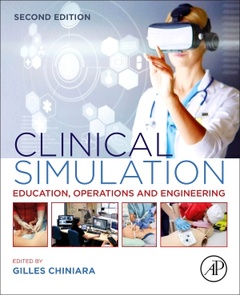Clinical Simulation (2nd Ed.) Education, Operations and Engineering
Coordonnateur : Chiniara Gilles

Clinical Simulation: Education, Operations and Engineering, Second Edition, offers readers a restructured, comprehensive and updated approach to learn about simulation practices and techniques in a clinical setting. Featuring new and revised chapters from the industry?s top researchers and educators, this release gives readers the most updated data through modern pedagogy. This new edition has been restructured to highlight five major components of simulation education, including simulation scenarios as tools, student learning, faculty teaching, necessary subject matter, and the learning environment. With clear and efficient organization throughout the book, users will find this to be an ideal text for students and professionals alike.
I. FOUNDATIONS IN CLINICAL SIMULATION 1. A Brief History of Clinical Simulation: How Did We Get Here? 2. The Many Faces of Simulation 3. Simulated and Standardized Patients 4. Virtual Patients and Serious Games 5. Physiologic Modeling for Simulators
II FOUNDATIONS IN CLINICAL SIMULATION 6. Adapting Learning in a Simulated Environment 7. Adult Learning and Simulation-Based Education 8. Theory for Practice: Learning Theories for Simulation 9. Simulation-Based Education and the Challenge of Transfer 10. Using Cognitive Load Theory to Optimize Simulation Design 11. Motivational Dynamics in Simulation 12. Learning Through PlayTraining 13. Simulation as a Social Event: Stepping Back, Thinking About Fundamental Assumptions
III BUILDING EFFECTIVE SIMULATION EXPERIENCES 14. Educational Foundations of Instructional Design Applied to Simulation-Based Education 15. Theory and Practice of Developing an Effective Simulation Curriculum 16. Creating Effective Learning Environments: The Educator’s Perspective 17. Assessing and Planning for Simulation Implementation: An Approach to Instructional Design to Meet Organizational Needs 18. When Simulation Should and Should Not Be in the Curriculum 19. Integrating Simulation to Existing Educational Programs 20. Planning and Assessing Clinical Simulation Using Task Analysis 21. Theoretical Underpinnings of Scenario Design 22. Key Issues in Scenario Design for Simulation 23. A Systematic Approach to Scenario Design 24. A Pragmatic Approach to Scenario Scripting
IV THE GOALS AND OBJECTIVES OF LEARNING 25. Crisis Resource Management and Nontechnical Skills: From Individuals to Teams, From Danger to Safety 26. Simulation for Learning Clinical Reasoning 27. Simulation for Procedural Tasks 28. Simulation for Pediatrics and Neonatal Care 29. Simulation for Critical Care 30. Simulation for Obstetrics 31. Simulation for Pharmacy 32. Simulation for Workplace Adaptation and Organizational Change
V IMPLEMENTING SIMULATION 33. Prebriefing and Briefing 34. Debriefing Frameworks and Methods 35. Debriefing for the Transfer of Learning: A Cognitive Approach 36. Realism and the Art of Simulation 37. Moving Beyond Fidelity 38. In Situ Simulation
VI IMPLEMENTING SIMULATION 39. Simulation Facility Design 101: The Basics 40. Creation of Structure-Function Relationships in the Design of a Simulation Center 41. The One-Room Schoolhouse for Simulation 42. The One-Room Schoolhouse: A Practical Example 43. The Dedicated Clinical Simulation Suite 44. Simulation in Remote Areas 45. Simulation on a Low Budget 46. Funding for Simulation 47. Creative Procurement for Your Simulation Program 48. Evaluating and Choosing Patient Simulators and Equipment 49. Technological Infrastructure 50. Professional Stagecraft: Creating Simulated Clinical Environments 51. Governance and Administration of Simulation Programs: Providing the Structure and Strategic Foundation for Excellence 52. An Innovative Way to Think About a Simulation Center’s Core Administrative Functions: Comparing Managing a Simulation Facility to a Restaurant 53. Challenges in Simulation Implementation: A National Simulation Program in Germany
VII IMPLEMENTING SIMULATION 54. Roles and Functions in a Simulation Center 55. Considerations on the Training of Simulation Educators 56. Train-the-Trainers: Creating Simulation Educators
VIII ASSESSMENT 57. Simulation for Assessment 58. Simulation and High-Stakes Assessment 59. Evaluating Simulation Programs Throughout the Program Development Life Cycle 60. Accrediting Simulation Programs
- Edited by a leading educator, consultant and practitioner in the clinical simulation field
- Redesigned structure emphasizes the five components of simulation pedagogy
- Contains over 30 new chapters that feature the most up-to-date industry information and practices
Date de parution : 08-2019
Ouvrage de 992 p.
19x23.3 cm
